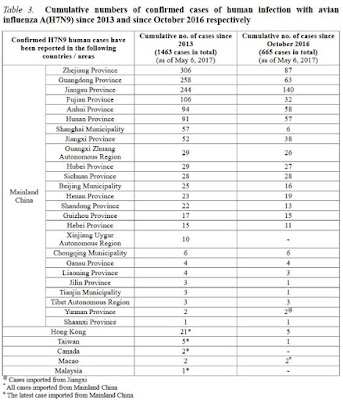 |
| Credit HK CHP |
#12,442
Hong Kong's Centre For Health Protection has published their latest weekly avian influenza report which details 24 recent H7N9 cases on the mainland, 22 of which were announced by the NHFPC last Friday.
The HK report adds to the list provided by the NHFPC one of the (now 4) recent cases from Shaanxi Province, and a second (belated) case report from Chongqing.Given the inherent delays in reporting, practically all of these cases would have had onset of illness in the second half of April
The three hardest hit provinces this year (Zhejiang, Guangdong, and Jiangsu) continue to report very few cases, while previously largely unscathed provinces (Sichuan, Hebei, etc.) are bearing the brunt of this 5th epidemic's late season activity.
Avian Influenza Report
Avian Influenza Report is a weekly report produced by the Respiratory Disease Office, Centre for Health Protection of the Department of Health. This report highlights global avian influenza activity in humans and birds.
VOLUME 13, NUMBER 18
Reporting period: April 30, 2017 – May 6, 2017 (Week 18)
(Published on May 9, 2017)
Summary
1. Since the previous issue of Avian Influenza Report (AIR), there were 24 new human cases of avian influenza A(H7N9) reported by health authorities of Mainland China in Hebei (7 cases), Sichuan (6 cases), Chongqing (2 cases), Anhui (1 case), Beijing (1 case), Gansu (1 case), Guangxi (1 case), Henan (1 case), Hubei (1 case), Hunan (1 case), Jiangsu (1 case) and Shaanxi (1 case). Since March 2013 (as of May 6, 2017), there were a total of 1463 human cases of avian influenza A(H7N9) reported globally. Since October 2016 (as of May 6, 2017), 657 cases have been recorded in Mainland China.
2. Since the previous issue of AIR, there were no new human cases of avian influenza A(H5N6). Since 2014 (as of May 6, 2017), 16 human cases of avian influenza A(H5N6) were reported globally and all occurred in Mainland China. The latest case was reported on December 1, 2016.
3. Since the previous issue of AIR, there were no new human cases of avian influenza A(H5N1). From 2011 to 2016, 10 to 145 confirmed human cases of avian influenza A(H5N1) were reported to the World Health Organization (WHO) annually (according to onset date). In 2017, there have been so far two cases in Egypt.*
(Continue . . . )
The age and gender skewing of cases continues, with only 2 of 24 cases under the age of 30 (ages 26 & 25), and 15 of 24 are male.
Nine cases (37.5%) are already listed as fatal - unusually high for an initial report - since death is generally a trailing indicator, usually coming after weeks of treatment.While this may just be an errant blip in the data - one is reminded of concerns raised last month (see Eurosurveillance: Preliminary Epidemiology & Analysis Of Jiangsu's 5th H7N9 Wave) of a recently observed `accelerated disease progression of H7N9 patients'.
Although mild cases are known to occur, they are very rarely reported, and none are reported this week.
Presumably only the `sickest of the sick' seek treatment, and are therefore tested and counted. The actual burden of the disease - and its mortality rate - are a matter of continued debate (see Beneath The H7N9 Pyramid).
With warmer summer temperatures the number of cases is expected to sharply decline in the coming weeks. At least that's been the pattern after the first 4 epidemic waves.
Given H7N9's propensity for change, we can only wait to see what happens this year.

